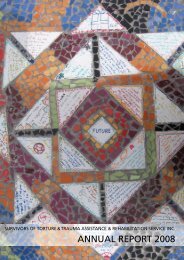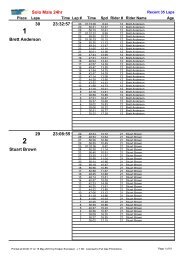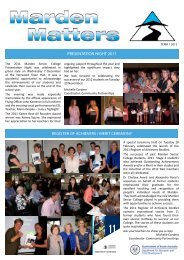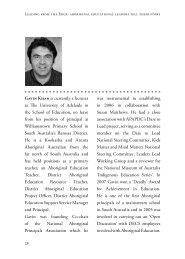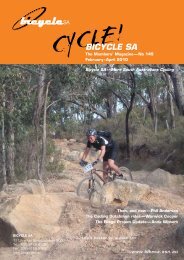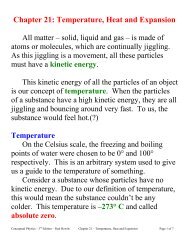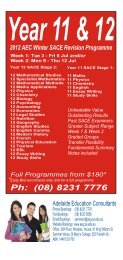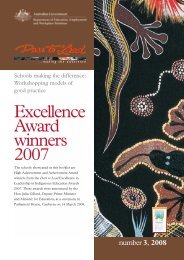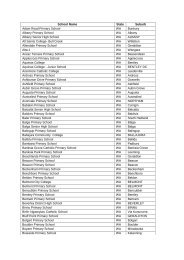You also want an ePaper? Increase the reach of your titles
YUMPU automatically turns print PDFs into web optimized ePapers that Google loves.
they don’t test for anything, they just treat with a<br />
very strong dose of antibiotics, and they wonder<br />
why they have a problem with resistance! She<br />
was kept in hospital all day until 10pm when the<br />
doctor finally returned (three hours late!) after a<br />
long lunch and who knows what else. Finally I<br />
was able to get her back to our nice and cheap<br />
(12 soles = US$4.50) family run hospedaje ‘La<br />
Casita’ run by Rosita and with a few days rest<br />
and her own medical treatment, she was in much<br />
better shape to continue.<br />
rio Marinon ‘a grand canyon to cross’<br />
The next stretch from Leymebamba to<br />
Cajamarca included our biggest climb, descent<br />
and climb yet in the Andes, up to 3600 m, then<br />
down to 980 m and then back up to 3100 m.<br />
The 60 km continuous descent from ‘Black<br />
Mud Pass’ at 3600 m took us nearly four hours<br />
of riding time to drop 2600 m of elevation, but at<br />
good gradients and sweeping corners we enjoyed<br />
the longest sustained dirt downhill of our trip...!<br />
We just couldn’t help but think we were about to<br />
pay big time for this on the way back up!<br />
The heat down at Balsas at the Rio Marañon<br />
wasn’t as bad as we had expected, in fact the<br />
rain had actually followed us all the way down<br />
but as soon as we started climbing out the other<br />
side through a desert landscape of cactus, wild<br />
donkeys and spiny plants the sun came out and<br />
we cooked as we climbed in the late morning sun.<br />
Lacking the energy needed to go on and with<br />
a mere 1000 m climb ahead of us, we ended up<br />
camping at the midway point above a farmer’s<br />
creek bed with the next stretch of climbing zigzagging<br />
its way up the mountain above our camp.<br />
The next morning we were both a bit more full<br />
of energy and tackled the final 1000 m to the top<br />
at 3100 m including those long but not so steep<br />
switch-back climbs.<br />
It was here that we met Peter and Miriam (a<br />
Dutch couple driving the Americas in their French<br />
Camper) for the third time on our trip, the first<br />
time in Baja California, then in Quilotoa, Ecuador<br />
and now in northern Peru. Unfortunately for them<br />
they had a run in with a cliff the day before when<br />
they lost traction on the clay roads and kissed the<br />
wall... Better than the other option, off the edge!<br />
Life’s better on a bike >>><br />
Celendin<br />
After the pass at 3100 m we rolled down<br />
into Celendin and into the first cheap looking<br />
hospedaje ‘Hospedaje Ebe Nezer’ and got a huge<br />
room with three beds, enough space to hang up<br />
our wet tent, sleeping mats and gear for only 10<br />
soles (US$3.80) and best of all a restaurant in<br />
the courtyard with a trained chef who specialised<br />
in ‘tamales’, ‘humitas’ and ‘juanes’. As a result we<br />
learned how to make some good local specialties<br />
and ate plenty of them as well of course, a nice<br />
break from the mundane Latin American culinary<br />
world of ‘comida vegetariana = rice, beans and a<br />
fried egg’ we have experienced so far.<br />
‘Juanes’ (traditionally from the jungle areas<br />
of Amazonas) quickly became our favourite with<br />
ground up Yuca, flavoured with some sort of stock<br />
and oil, stuffed with cheese, kalamata olives,<br />
boiled egg and chicken (if you like some dead<br />
bird in your ‘Juane!’), very rich but delicious. I think<br />
we ate four each in our first afternoon sitting!<br />
Celendin itself was a hustling, bustling, rural<br />
indigenous market town that didn’t blink an eyelid<br />
and carried on ‘business as usual’ as we spent<br />
another day of recovery from our stomach bugs.<br />
The fashion in Celendin was very interesting:<br />
big straw sombreros are in in these parts of<br />
the highlands. Scrawny cowboys in dirty denim<br />
wandered the streets in groups with a drunken<br />
swagger wearing comically oversized sombreros<br />
looking like cartoon characters. The women too<br />
also wore the tall oversized sombreros (great sun<br />
protection for working out in the fields we figure)<br />
along with a woven skirt over the top of 1980s<br />
style school tracksuit pants with white sneakers<br />
and sports socks... Interesting and very flattering<br />
indeed!<br />
Then just a lazy double pass of 3200 m and<br />
then 3700 m to cross between Celendin and<br />
Cajamarca on more rocky but good dirt roads.<br />
Not a lonely road for us with kids joining us on<br />
their bikes and others running out to greet us from<br />
the local schools.<br />
Very much dairy farming country too, donkeys<br />
and horses loaded up with metal milk jugs on<br />
their way to the ‘centro de enfriamento de leche’,<br />
(milk processing plants) at various places along<br />
the route.<br />
Cajamarca... Atahaulpa y los Banos del<br />
inca<br />
By the time we reached Cajamarca we felt we<br />
had deserved a little break with the hard stretch<br />
of climbing as well as our stomach problems<br />
(hopefully) behind us, and the tough six days or<br />
so ahead of us to Trujillo via the backroads and<br />
Haumachuco.<br />
We soaked our bones at the thermal baths<br />
of ‘Los Banos del Inca’, 6 km east of town just<br />
as Atahualpa the Incan King had been bathing<br />
his war wounds fresh from the civil war with his<br />
brother Huascar, and was camped at the natural<br />
thermal springs when Pizarro and his Spanish<br />
troops arrived in Cajamarca on 15 November<br />
1532.<br />
Atahualpa was tricked into a meeting in the<br />
main plaza with the Spanish and ordered most<br />
of his troops to remain outside, only entering the<br />
plaza with 6000 men armed with slings and hand<br />
axes. When Atahualpa refused to take the bible<br />
offered to him by a Spanish friar, throwing it to<br />
the ground (maybe he just didn’t understand it in<br />
Spanish?), the Spanish attacked and massacred<br />
over 6000 indigenous people and captured<br />
Atahualpa.<br />
Even after the ransom of 6 000 kg of gold and<br />
12 000 kg of silver had been paid the Spanish<br />
were still paranoid about the possibility of an<br />
attack. On 26 July 1533 Atahualpa was led out<br />
to the plaza to be burned at the stake, and at<br />
the last minute accepted baptism (he was given<br />
the name ‘Francisco Atahualpa’) in return for a<br />
quicker death of strangulation and he was hung.<br />
Nice work Pizarro!<br />
Just a little bit of history for you on the<br />
conquest of the Incan Empire by the Spanish. I’m<br />
sure there’ll be more to come further into Peru...!<br />
Enjoy!<br />
(PS to other cyclists: if anyone wants more<br />
info on this route into Peru feel free to email us<br />
and we’ll send more details, or check out the<br />
route descriptions of the Hobobikers at . It’s well worth the pain ‘vale la<br />
pena’, trust us!)<br />
For full story and photos, go to .<br />
May – July 2010 >>>> 17





